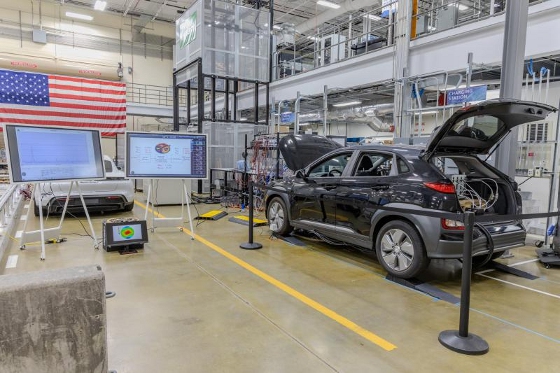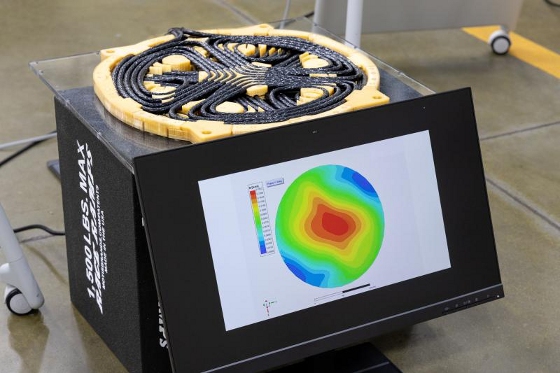 |
| March 26, 2024 | Volume 20 Issue 12 |
Designfax weekly eMagazine
Archives
Partners
Manufacturing Center
Product Spotlight
Modern Applications News
Metalworking Ideas For
Today's Job Shops
Tooling and Production
Strategies for large
metalworking plants
Wireless EV charging rates now comparable to wired fast chargers

ORNL researchers achieved the highest wireless power transfer level for a light-duty passenger vehicle when the team demonstrated a 100-kW wireless power transfer to an EV using ORNL's patented polyphase electromagnetic coupling coil. [Credit: Genevieve Martin/ORNL, U.S. Dept. of Energy]
A team of researchers at Oak Ridge National Laboratory (ORNL) recently demonstrated that a light-duty passenger electric vehicle can be wirelessly charged at 100 kW with 96% efficiency -- comparable to conventional, wired high-power fast chargers -- using polyphase electromagnetic coupling coils with rotating magnetic fields.
ORNL's patented system transferred power to a Hyundai Kona EV across a 5-in. air gap using electromagnetic fields, a process similar to the wireless charging of small consumer devices such as smartphones.
"We've achieved the highest power density in the world for a wireless charging system for this class of vehicle," ORNL's Omer Onar said. "Our technology reaches power densities eight to ten times higher than conventional coil technology and can increase battery charge state by 50% in under 20 minutes."
While the same researchers previously achieved a 120-kW charge using conventional coil technology in benchtop lab testing, this marks a milestone achievement for vehicle integration using ORNL's polyphase coils. For the 120-kW development, the ORNL team created a new coil design co-optimized with the latest silicon carbide power electronic devices for a lightweight, compact system. The system's architecture takes energy from the grid and converts it to high-frequency alternating current, which generates a magnetic field that transfers power across a large air gap. Once the energy is transferred to the secondary coil, it is converted back to direct current and stored in a vehicle's batteries.
"We used finite element and circuit analyses to develop a novel co-optimization methodology, solving the issues of coil design while ensuring the system doesn't heat up or pose any safety issues, and that any loss of power during the transfer is minimal," said project lead Veda Galigekere of ORNL's Power Electronics and Electric Machinery Group.

ORNL's lightweight polyphase electromagnetic coupling coil design, with a diameter just over 14 in., allows for higher power density in smaller coils and includes rotating magnetic fields generated by coil phase windings. [Credit: Genevieve Martin/ORNL, U.S. Dept. of Energy]
For the latest round of charger development, the polyphase electromagnetic coupling coil's lightweight and small design allows for the highest power density within the smallest coils possible. Rotating magnetic fields generated by the coil phase windings boost the power.
"This is a breakthrough achievement and opens the door to fast and efficient wireless charging for passenger electric vehicles," Onar said.
Source: Oak Ridge National Laboratory
Published March 2024
Rate this article
View our terms of use and privacy policy
